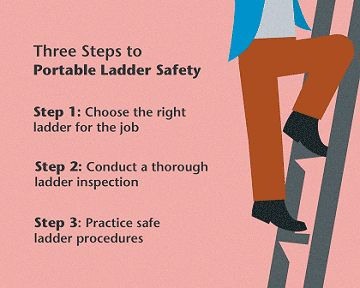- Home
- Loss Control
- Loss Control Insights
- Three Steps to Portable Ladder Safety
Work–related falls from ladders cause over 100 deaths and nearly 15,500 nonfatal injuries annually according to the Centers for Disease Control and Prevention. The Occupational Safety & Health Administration (OSHA) believes that 100 percent of all ladder accidents could be prevented if proper attention to equipment and training are provided.
During risk assessments of schools and other organizations, EMC Program Development Engineer Neil Wysocki routinely sees examples of what he refers to as “ladder abuse”— everything from worn ladders, stools being used rather than ladders and people not using ladders correctly. Wysocki recommends clients adopt the following three steps to reduce the likelihood of a misstep when using portable ladders.
Step 1. Choose the Right Ladder for the Job
Remember the saying, choose the right tool for the job? There’s a right ladder for the job, too. OSHA offers the following guidelines:
- For indoor use, stepladders or multipurpose ladders are usually recommended. For outdoor work, taller stepladders, multipurpose or extension ladders are generally more appropriate.
- Do not use aluminum ladders when working around electricity.
- Make sure that the ladder is the proper length to do the job safely.
- Choose a ladder that is designed for how you intend to use it. For example, do not use stepladders in a folded and leaned position in place of a straight ladder.
- Choose a ladder that is capable of supporting your weight and the weight of any materials you will be using.
Step 2. Conduct a Thorough Ladder Inspection
Before using a ladder, check it carefully to ensure there are no visible defects and that it is in good working condition. Check for the following items:
- Ladders have no broken or defective rungs or side rails, and rungs are firmly attached to the side rails.
- The locking mechanism on the spreader is operating properly.
- Ladders have no rails, screws or splinters sticking out.
- Rungs have no oil or grease on them.
- Nonslip safety feet or bases on ladders are in good condition.
- Nonslip safety material or ladder rungs are in good condition.
- Interiors of open–end hollow rungs of metal ladders are free from corrosion.
- If the ladder is damaged, it must be removed from service until repaired or replaced.
Step 3. Practice Safe Ladder Procedures
It may look simple, but setting up and climbing a ladder requires training and attention. Follow these OSHA safety procedures:
- Look for overhead power lines before handling a ladder. Avoid using a metal ladder near power lines or exposed energized electrical equipment.
- Always maintain three points of contact (e.g., two hands and a foot, or two feet and a hand) on the ladder when climbing. Keep your body near the middle of the step and always face the ladder while climbing.
- Do not use the top step/rung of a ladder unless it was designed for that purpose.
- Use a ladder only on a stable and level surface, unless it has been secured (top or bottom) to prevent displacement.
- Do not place a ladder on boxes, barrels or other unstable bases to obtain additional height.
- Do not move or shift a ladder while a person or equipment is on the ladder.
- An extension or straight ladder used to access an elevated surface must extend at least three feet above the point of support.
- Follow the four–to–one ratio. For every four feet of height, the base of the ladder must be one foot away from the support. For example, if your ladder is resting on a wall 16 feet from the ground, the base of your ladder should be 4 feet away from the wall.
A Word About Ladder Policies
In addition to the three steps noted above, EMC recommends that employers develop a ladder policy. The policy should include the name of the person responsible for the storage and condition of ladders, which employees are authorized to use ladders, a ladder inspection checklist and procedures for removing defective ladders from service. Your EMC loss control specialist can assist you in developing a ladder safety policy.
Need To Know More?
Here are some valuable ladder safety documents you may want to review:
Get in touch
Need help? We’re here for you! Whether you have questions or need personalized assistance, your local office is ready to support you.
Loss Control Insights
Stay informed with the latest news and receive actionable safety tips, all carefully curated by our team of experts.
